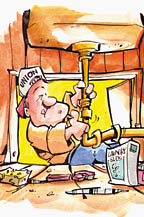
But it’s time to stop saying nice things about the United Association. It is missing a grand opportunity to boost its ranks and improve the industry. For years the UA has been talking about paying more attention to the service market. Unfortunately, it seems to have been mostly talk. Nobody I know in the PHC residential service business has seen any progress.
Several years ago I got a call from a union organizer asking me for advice on how to recruit more nonunion companies to the fold. Simple, I told him. Everybody is looking for qualified service technicians. Everyone knows the UA has the best technical training around, except most of it is geared toward new construction work. The UA has made a push of sorts to capture some residential construction work in recent years, but they have paid almost no attention to the residential service business.
It’s a shame, because those of us in this business are desperate for trained technicians. But repairs and retrofits require quite different skills than construction work.
The Four-Letter Word
The technical skills are the easiest obstacle to overcome, however. Almost all UA journeymen can be trained in relatively short order to diagnose and fix homeowners’ problems. The bigger thing that’s holding back the UA is its aversion to the human-relations aspect of service work. This includes that dreaded four-letter word, “sell.”The UA argues quite convincingly that its people are well worth the higher compensation packages they earn compared with nonunion construction plumbers and fitters. Labor costs may be higher, but you can be confident the job will be done right, it says. There will be fewer callbacks, and the systems will last longer and operate better. In the long run, you save money. That, in a nutshell, is the union’s pitch to construction owners. Implicit in this pitch is that the owners may have to pay more on the front end for better quality.
Nothing wrong with that. Yet, when it comes to service work, a lot of union members and officials have the same blind spot most others in the industry do in being hung up on time-and-material pricing and the “going rate.” They have no problem with the idea of their men getting twice the pay of the average nonunion service technician, but they go bonkers at the thought of a service contractor charging twice the “going rate” for PHC services in a given area.
The UA used to be a significant factor in the residential service market decades ago. The UA never did “lose” that business as much as it voluntarily relinquished it. Union plumbers and pipefitters wanted to work the higher-paying commercial and industrial jobs, and who can blame them. But why is it that residential plumbers have to settle for less money than those who work on commercial jobs? The excuse is that commercial work is more complex, but I don’t buy that. It’s not about bigger diameter pipe. Service work involves brains more than brawn. It’s about diagnosing homeowners’ problems and finding solutions. Look around and you’ll find that occupations relying on brainwork tend to pay more than those based on muscle.
Another problem is that, to the average UA member, “sell” is the worst possible four-letter word. They have no trouble selling a commercial building owner on paying more for union labor. But they can’t buy into the fact that service rates are way too low to support highly skilled technicians such as themselves. Suggest to them that they adopt flat-rate pricing as a way of doing so, they shudder at the thought. And they go really bonkers at the thought that homeowners might benefit from a $500 faucet or toilet. Union or nonunion, plumbers feel much more comfortable installing the same old stuff home centers sell.
The Future Service Market
Speaking of home centers, I have a feeling that the residential service market of the future is going to be owned by the likes of Home Depot. Recently they established a partnership with Service Master for service referrals on various kinds of home installations and maintenance work. I don’t know where that will lead, but it’s not too farfetched to envision a time in the future when Home Depot might buy Service Master or some other large service organization. Home Depot doesn’t turn its nose up at the residential service market. They know there is opportunity there and money to be made.The same holds true for the UA, except it will require an entirely different mentality about the way they do business — and yes, union organizing is a business. When I spoke to that UA recruiter a few years ago, I shared with him my vision of a future in which the UA could capture the residential service market by acting not so much like a union as an employment agency.
Do away with union dues, I suggested. Make the employer pay the freight for the technicians that come from the hiring hall. They would do well even to operate on a commission basis, earning a percentage of the service technician’s billings. The UA would find a sizable and enthusiastic market for its “product” if service contractors could pay on the basis of what the technician brings in to the business.
Such a system would also do away with the agonizing process of labor negotiations that so often turn into bitter recriminations by each side. It would be a win-win-win situation for the union, the contractor and the technician alike. It would result in higher pay scales for qualified technicians, more prosperous contractors, and even more lavish Taj Mahal-like offices for UA officials around the country.
A new century has dawned, my friends. It’s time to start thinking new thoughts.